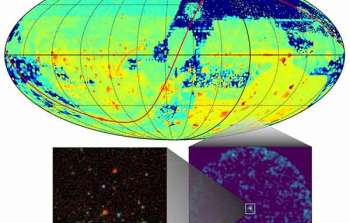sci17032 — Announcement
Dark Energy Survey’s First Data Release Accessible via the NOAO Data Lab
November 30, 2017
Finding a dwarf galaxy in a crowd-sourced survey of the sky. Map of total exposure time for all DECam and Mosaic images (2004 - 2017) on a log scale (top). A Data Lab query of the DES DR1 catalog for blue sources near the known dwarf galaxy Eri III, when spatially filtered, reveals the galaxy as an object density peak (lower right). A Data Lab image cutout of the region (lower left) shows a very low surface brightness collection of blue point sources, confirming that it is a dwarf galaxy.
Wednesday, 10 January 2018, 2:00-3:30 pm, Potomac Ballroom C
Demo at the January AAS meeting, NOAO Booth
Knut Olsen and Joan Najita (NOAO)
The Dark Energy Survey (DES), now in its final observing season, will issue its first data release on 10 January 2018 in conjunction with a special session at the January AAS meeting. The data will be available through the NOAO Data Lab (https://datalab.noirlab.edu/) and other portals. Drop by the NOAO booth at the AAS meeting to see a demonstration, using the DES data, of Data Lab’s current visualization and exploration capabilities.
Currently being carried out with the Dark Energy Camera (DECam) on the CTIO 4-m Blanco telescope, DES is designed to probe the nature of dark energy by mapping hundreds of millions of galaxies, detecting thousands of supernovae, and searching for patterns of cosmic structure. Data included in the release cover the full DES footprint, spanning 5000 square degrees of the southern sky. Both images and catalogs will be available.
Although the 570-megapixel DECam was built to carry out the DES, it has also been actively used by the community for other science programs. Community use of DECam and other NOAO survey instruments have effectively contributed to a crowd-sourced survey of nearly the entire sky (see Figure). Survey data sets in the NOAO science archive now stand in excess of 2PB.
The goal of the NOAO Data Lab is to facilitate community re-use of these massive surveys by enabling visualization and exploration of their images and catalogs. The Data Lab hosts the catalogs provided by the survey teams (e.g., DES DR1 and Legacy Survey DR3, DR4, and DR5 and DECaPS) and is producing its own nearly all-sky catalog, the NOAO Source Catalog, from the public images.
A demonstration of current Data Lab capabilities using DES data (DES DR1) will be featured at the NOAO booth. With Data Lab, users will be able to 1) explore the DES DR1 sky; 2) create a user account; 3) query the DES DR1 catalog query through the web, Python, command line, or TOPCAT; 4) retrieve DES DR1 image cutouts; 5) store results in virtual storage or a personal database; and 6) script analysis through Jupyter notebooks.
Stop by the NOAO booth in DC to see the demonstration!
About the Announcement
| Id: |
ID
sci17032
|
